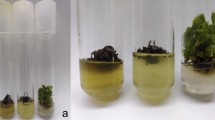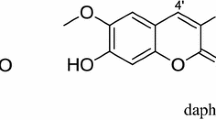Abstract
Chalcones are flavonoid precursors that recently have been found to disrupt mitochondrial function and induce apoptosis in Arabidopsis radicles. However, whether they are potentially useful for weed control as selective herbicides depends on whether they are phytotoxic for important weeds and are not toxic for crops. This work determines the phytotoxicity of chalcone for the germination and early development of a variety of crop species and associated weeds. Also, the phytotoxic potential was investigated in chalcone-watered or sprayed adult plants of Arabidopsis, a common model in phytotoxicity assays. Chalcone was detrimental mainly to the germination of Plantago lanceolata and Lactuca sativa and to the early root growth of Amaranthus retroflexus, Echinochloa crus-galli, and P. lanceolata, and likewise detrimental to the development of adult Arabidopsis. The morphology and physiology of adult Arabidopsis plants watered or sprayed with chalcone confirmed that this metabolite is also phytotoxic for adult plants and showed that the mechanism of its action on plant metabolism depends on whether it is administered by spraying or watering. These results support the role of chalcone as a plant growth regulator and its potential use in weed management in the field.









Similar content being viewed by others
References
Besseau S, Hoffmann L, Geoffroy P, Lapierre C, Pollet B, Legrand M (2007) Flavonoid accumulation in Arabidopsis repressed in lignin synthesis affects auxin transport and plant growth. Plant Cell 19:148–162
Bitencourt HR, Santos LS, Souza APS (2007) Actividade alelopática de chalcona sintética, de seus precursores e de cetonas e aldehídos relacionados. Planta Daninha 25:747–753
Bradbeer JW (1988) Seed dormancy and germination. Blackie and Son Ltd., Glasgow
Bradford MM (1976) A rapid and sensitive method for the quantitation of microgram quantities of protein utilizing the principle of protein-dye binding. Anal Biochem 72:248–254
Brown DE, Rashotte AM, Murphy AS, Normanly J, Tague BW, Peer WA, Taiz L, Muday GK (2001) Flavonoids act as negative regulators of auxin transport in vivo in Arabidopsis. Plant Physiol 126:524–535
Céspedes CL, Achnine L, Lotina-Hennsen B, Salazar JR, Gómez-Garibay F, Calderón J (2001) Inhibition of photophosphorylation and electron transport by flavonoids and biflavonoids from endemic Tephrosi spp. of Mexico. Pest Biochem Physiol 69:63–76
Chen M, Brøgger ChS, Zhai L, Rasmussen MH, Theander TG, Frøkjaer S, Steffansenvb DJ, Kharazmi A (1997) The novel oxygenated chalcone, 2,4-dimethoxy- 4′-butoxychalcone, exhibits potent activity against human malaria parasite Plasmodium falciparum in vitro and rodent parasites Plasmodium berghei and Plasmodium yoelii in vivo. J Infect Dis 176:1327–1333
Chiapusio G, Sánchez AM, Reigosa MJ, González L, Pellissier F (1997) Do germination indices adequately reflect allelochemical effects on the germination process? J Chem Ecol 23:2445–2453
Dayan FE, Romagni JG, Duke S (2000) Investigating the mode of action of natural phytotoxins. J Chem Ecol 26:2079–2094
Desgagné-Penix I, Eakanunkul S, Coles JP, Phillips AL, Hedden P, Sponsel VM (2005) The auxin transport inhibitor response 3 (tir3) allele of BIG and auxin transport inhibitors affect the gibberellin status of Arabidopsis. Plant J 41:231–242
Díaz-Tielas C, Graña E, Sotelo T, Reigosa MJ, Sánchez-Moreiras AM (2012) The natural compound trans-chalcone induces programmed cell death in Arabidopsis thaliana roots. Plant Cell Environ 35:1500–1517
Duke SO, Rimando A, Scheffler B, Dayan FE (2002) Strategies for research in applied aspects of allelopathy. In: Reigosa MJ, Pedrol N (eds) Allelopathy: from molecules to ecosystems. Science Publishers Inc., Plymouth, pp 139–152
Frigerio M, Alabadí D, Pérez-Gómez J, García-Cárcel L, Phillips AL, Hedden P, Blázquez MA (2006) Transcriptional regulation of gibberellin metabolism genes by auxin signaling in Arabidopsis. Plant Physiol 142:553–563
Friis-Møller A, Chen M, Fuursted K, Christensen SB, Kharazmi A (2002) In vitro antimycobacterial and antilegionella activity of licochalcone A from Chinese licorice roots. Planta Medica 68:416–419
González JA, Estévez-Braun A (1998) Effect of (E)-chalcone on potato-cyst nematodes (Globodera pallida and G. rostochiensis). J Agric Food Chem 46:1163–1165
Gray WM, Östin A, Sandberg G, Romano CP, Estelle M (1998) High temperature promotes auxin-mediated hypocotyl elongation in Arabidopsis. Proc Natl Acad Sci USA 95:7197–7202
Harborne JB (1966) Comparative biochemistry of the flavonoids-I. Distribution of chalcone and alurone pigments in plants. Phytochemistry 5:111–115
Hoagland RE, Williams RD (2004) Bioassay—useful tool for the study of allelopathy. In: Macías FA, Galindo JCG, Molinillo JMG, Cutler HG (eds) Allelopathy. Chemistry and mode of action of allelochemicals. CRC Press, Boca Raton, FL, pp 315–351
Hodges DM, Delong JM, Forney CF, Prange RK (1999) Improving the thiobarbituric acid-reactive-substances assay for estimating lipid peroxidation in plant tissues containing anthocyanin and other interfering compounds. Planta 207:604–611
Hsu YL, Kuo PL, Tzeng WS, Lin CC (2006) Chalcone inhibits the proliferation of human breast cancer cell by blocking cell cycle progression and inducing apoptosis. Food Chem Toxicol 44:704–713
Jäderlund A, Zackrisson O, Nilsson MC (1996) Effects of bilberry (Vaccinium myrtillus L.) litter on seed germination and early seedling growth of four boreal tree species. J Chem Ecol 22:973–986
Khandakar AL, Bradbeer JW (1983) Jute seed quality. Agricultural Research Council, Dhaka
Klughammer C, Schreiber U (2008) Complementary PS II quantum yields calculated from simple fluorescence parameters measured by PAM fluorometry and the saturation pulse method. PAM Appl Notes 1:27–35
Kramer DM, Johnson G, Kiirats O, Edwards GE (2004) New fluorescence parameters for the determination of QA redox states and excitation energy fluxes. Photosynth Res 79:209–218
Kwon D, Yoon S, Carter O, Bailey GS, Dashwood RH (2006) Antioxidant and antigenotoxic activities of Angelica keiskei, Oenanthe javanica and Brassica oleracea in the Salmonella mutagenicity assay and in HCT116 human colon cancer cells. Biofactors 26:231–244
Magome H, Yamaguchi S, Hanada A, Kamiya Y, Oda K (2004) Dwarf and delayed-flowering 1, a novel Arabidopsis mutant deficient in gibberellin biosynthesis because of overexpression of a putative AP2 transcription factor. Plant J 37:720–729
Margalef R (1961) Variaciones intraespecíficas de los pigmentos asimiladores en clorofíceas y fanerógamas acuáticas. Investig Pesq 19:111–118
Markham KR, Gould KS, Ryan KG (2001) Cytoplasmic accumulation of flavonoids in flower petals and its relevance to yellow flower colouration. Phytochemistry 58:403–413
Martínez-Peñalver A, Pedrol N, Reigosa MJ, Sánchez-Moreiras AM (2012) Tolerance of Arabidopsis thaliana to the allelochemical protocatechualdehyde. J Plant Growth Regul 31:406–415
Oxborough K, Baker NR (1997) Resolving chlorophyll a fluorescence images of photosynthetic efficiency into photochemical and non-photochemical components - calculation of qP and F’v/F’m without measuring F’o. Photosyn Res 54:135–142
Piñero J, Temporal RM, Silva-Gonçalves AJ, Jiménez IA, Bazzocchi IL, Oliva A, Perera A, Leon LL, Valladares B (2006) New administration model of trans-chalcone biodegradable polymers for the treatment of experimental leishmaniasis. Acta Trop 98:59–65
Rao AN, Johnson DE, Sivaprasad B, Ladha JK, Mortimer AM (2007) Weed management in direct-seeded rice. Adv Agron 93:153–255
Saydam G, Aydin HH, Sahin F, Kucukoglu O, Erciyas E, Terzioglu E, Buyukkececi F, Omaya SB (2003) Cytotoxic and inhibitory effects of 4,4′-dihydroxy chalcone (RVC-588) on proliferation of human leukemic HL-60 cells. Leuk Res 27:57–64
Viana GSB, Bandeira MAM, Matos FJA (2003) Analgesic and antiinflammatory effects of chalcones isolated from Myracrodruon urundeuva allemão. Phytomedicine 10:189–195
Wardle DA, Ahmed M, Nicholson KS (1991) Allelophatic influence of nodding thistle (Carduus nutans L.) seeds on germination and radical growth of pasture plants. New Zeal J Agric Res 34:185–191
Wellburn AR (1994) The spectral determination of chlorophylls a and b, as well as total carotenoids, using various solvents with spectrophotometers of different resolution. J Plant Physiol 144:307–313
Wu JH, Wang XH, Yic YH, Lee KH (2003) Anti-AIDS agents 54. A potent anti-HIV chalcone and flavonoids from genus Desmos. Bioorg Med Chem Lett 13:1813–1815
Acknowledgments
The authors thank the Central Research Services from the University of Vigo (CACTI) for technical assistance in element analyses. The authors want to thank also Ian Coleman for the translation into English and corrections made to the manuscript. This research was supported by the Regional Government of Galicia through Project No. 10PXIB310261PR and a grant to Elisa Graña, and by the Spanish Ministry of Science and Technology through a Grant (AGL2010-17885) to Carla Díaz.
Author information
Authors and Affiliations
Corresponding author
Additional information
Carla Díaz-Tielas and Tamara Sotelo contributed equally to this study.
Rights and permissions
About this article
Cite this article
Díaz-Tielas, C., Sotelo, T., Graña, E. et al. Phytotoxic Potential of Trans-chalcone on Crop Plants and Model Species. J Plant Growth Regul 33, 181–194 (2014). https://doi.org/10.1007/s00344-013-9360-6
Received:
Accepted:
Published:
Issue Date:
DOI: https://doi.org/10.1007/s00344-013-9360-6




